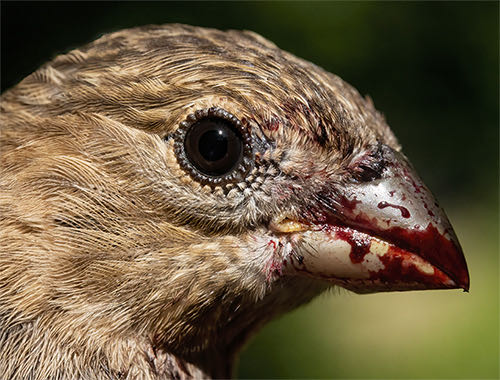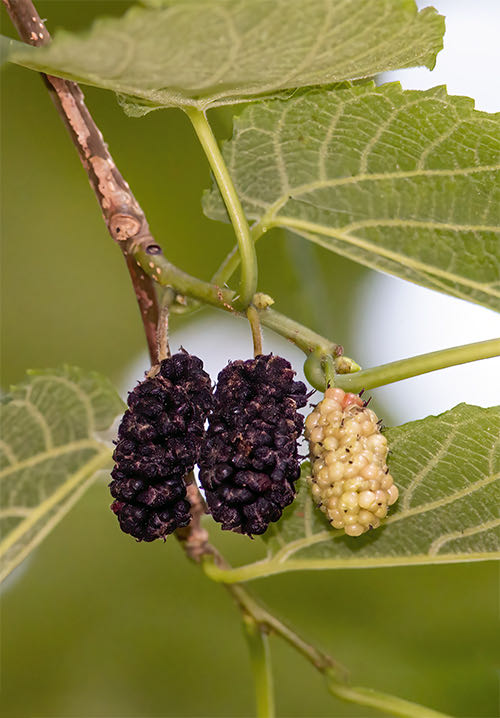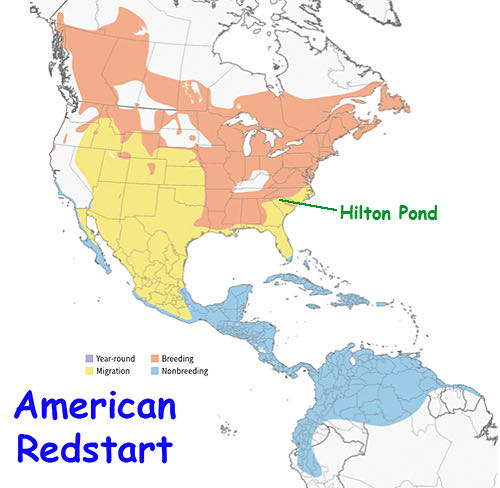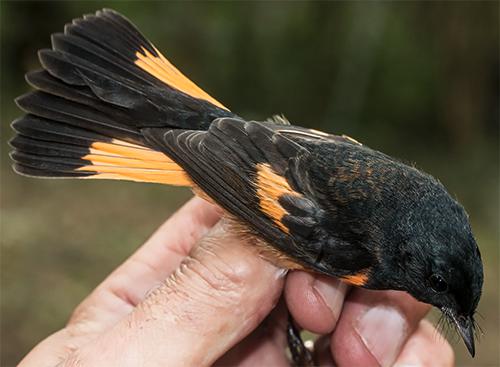- Established 1982 -HOME: www.hiltonpond.org
THIS WEEK at HILTON POND Subscribe for free to our award-winning nature newsletter (Back to Preceding Week; on to Next Week) |
CANNIBAL FINCHES? NOT. It looked like a frantic zombie scene outside the kitchen window of our old farmhouse at Hilton Pond Center: Splatters of blood strewn across the deck and even more blood dripping from the conical bills of half-crazed flesh-hungry House Finches devouring their siblings and parents. But wait! It wasn't avian cannibals after all--nor bloodstains--just sugar-rich blood-red juice from a backyard crop of Red Mulberries that ripened in June. House Finches of all ages were after those abundant berries with a vengeance and weren't being the slightest bit fastidious in their gluttonous pursuit of a tasty late spring delicacy.
All text, maps, charts & photos © Hilton Pond Center Three mulberry species are prominent in North America: White, Black, and Red. Some years they produce little fruit but this year the Center's Red Mulberry trees due to causes unknown yielded a bumper crop--right above the kitchen deck. For two weeks succulent fruits were everywhere, ripening beneath the leaves and dropping to the ground below--except when birds got to them first. We personally sampled quite a few and can verify their tastiness--although the berries were chock full of crunchy little achenes, the seeds that make new mulberry trees.
All text, maps, charts & photos © Hilton Pond Center All three mulberry types start out with whitish fruit, but only White Mulberries (Morus alba)--native to India and China and cultivated to feed silk-producing caterpillars--retain this pale color when ripe. (That said, White Mulberry occasionally turns dark red or purple.) Black Mulberry (M. nigra)--also from Asia but a poorer silkworm food--definitely makes purplish-black fruit, while our native and Red Mulberry (M. rubra) has yield that is either deep red or purplish-black. All three mulberries mentioned above occur in North America--about 20 species are accepted worldwide by taxonomists--and all have relatively heart-shaped leaves. That said, foliage is highly variable, sometimes entire and sometimes lobed and even varying on the same tree. (In fact, mulberry leaves are so variable they often have plant lovers scratching their heads. Part of the problem is mulberries hybridize readily, with both fruit and foliage showing "mixed" characteristics.) Mulberries are known to be monoecious (flowers of both sexes on the same plant) but typically are dioecious (sexes separate), in which case at least one male tree must be present for female trees to bear. It's when pollen from a male mulberry flower ends up on the "wrong" species that hybridization occurs.
All text, maps, charts & photos © Hilton Pond Center In the field, White Mulberry is identifiable by a leaf with a shiny top, but non-shiny leaves of Red Mulberry and Blackberry can be confusingly similar to each other. Typically, a Red Mulberry leaf is sandpapery rough on top, fuzzy below, and with leaf lobes having sharply pointed tips--as on the tree (above) outside our kitchen window; its petiole often exudes white sap when broken. In the Carolina Piedmont escaped Black Mulberry is much less common than the native Red Mulberry, but plentiful White Mulberry spreads easily and can even be invasive.
All text, maps, charts & photos © Hilton Pond Center We think we can safely conclude the audacious report of cannibalistic House Finches at Hilton Pond was erroneous and misleading. However, it IS true that in June 2022 our Red Mulberry trees did quite well at producing bird-attracting fruit with blood-red exudate. More juicy news to come when the Center's Pokeweed and Elderberry berries begin to ripen. All text, maps, charts & photos © Hilton Pond Center REDSTART MYSTERY Faithful readers know we often say we're surprised by a recent observation at Hilton Pond Center, and it's true. Even though we've been documenting organisms and natural history phenomena on the property for 41 years, seldom a week goes by we don't see something unexpected or thought-provoking--which gives us something new and exciting to write about for "This Week at Hilton Pond." Take the 13th of June 2022, for example, when while operating mist nets we captured a second-year female American Redstart (AMRE).
All text, maps, charts & photos © Hilton Pond Center Redstarts aren't rare at the Center--they're our third most commonly banded Wood Warbler at 611 in 41 years--but nearly ALL those captures have been during spring or fall migration . . . and 13 June is getting pretty close to summer. The latest we've ever banded a "spring" AMRE was 8 June 1992, so this week's bird was nearly a week later. (Our earliest apparent "fall" banding was a hatch-year male on 4 August 1992.) American Redstarts are relatively abundant during migration AND in summer across most of NORTH Carolina's Piedmont Province (see map below), but breeding records from the SOUTH Carolina Piedmont are scarce; we know of no confirmed breeding for our home county of York. (In the summer of 1999, two territorial pairs were reported from Sharon SC--about 10 miles west of the Center--but apparently a nest was not confirmed.)
All text, maps, charts & photos © Hilton Pond Center As an example of how important eBird reports can be, we checked that source on-line and were reminded Hilton Pond's June banding records are complemented by visual observations of local American Redstarts last year (2021) on 20, 21 & 29 July. These three mid-summer sightings strongly suggest AMRE are indeed nesting at or near the Center. (NOTE: eBird also shows past-year York County "summer" records from other observers--two sightings in June and two in July.)
All text, maps, charts & photos © Hilton Pond Center AMRE are strongly dimorphic, males (see our file photo above) being jet black with orange spots in tail, wing, and flank. Females like the one we banded this week (top photo) have gray heads and greenish bodies with yellow instead of orange; young males are similar, sometimes with flanks more salmon-colored. Our latest June capture at Hilton Pond Center was not in breeding condition--she didn't have a featherless brood patch on her belly--so we suspect she was simply a very late northbound migrant. (Plumage characters showed she was NOT a recent fledgling produced this year.) Nonetheless, American Redstart is a species that deserves more scrutiny by field observers in the South Carolina Piedmont, with the hope of determining just how frequently they do nest hereabouts. All text, maps, charts & photos © Hilton Pond Center HILTON POND SUNSETS "Never trust a person too lazy to get up for sunrise
All text, maps, charts & photos © Hilton Pond Center Sunset over Hilton Pond, 27 June 2022 For unity and common ground. And common sense. Don't forget to scroll down for lists of Hilton Pond supporters and of all birds banded and recaptured during the period. Photoshop image post-processing for this page employs |
|---|
|
"This Week at Hilton Pond" is written and photographed by Dr. Bill Hilton Jr., executive director of Hilton Pond Center for Piedmont Natural History
|
|
|
Please refer "This Week at Hilton Pond" to others by clicking on this button: |
|


















 Please report your
Please report your